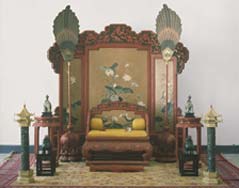
  
Translucent World is an exhibition of Chinese jade from the outstanding collection of the Palace Museum in Beijing, featuring the manifold uses of jade depicting nature as a reflection of human beliefs and emotions. Since ancient times, the Chinese have revered this ‘heavenly stone’, carved to produce the most prized ornaments and ceremonial implements. Nature, worked in a diversity of themes and styles over the millennia, has remained a potent source of inspiration for artisans. Since China's Neolithic period, real and imagined creatures of the earth - turtles, birds, dragons or other monsters - were endowed with special attributes, as revealed by their depiction in jade. Gradually the flora and fauna of nature became jade’s most important subject matter. After the Tang dynasty, the landscape with its mountains and streams came to occupy a distinguished place within jade’s thematic repertoire. Designed to decorate cultural implements or sculpted into evocative boulders, these works embodied the universal longing of cultivated individuals to escape their quotidian world to commune with nature. As a crucial component of the nature and its rhythms, humans are represented as part of this translucent world. Chinese depictions of nature through jade are seldom mere representations of the external world. Rather, they explore nature as a reflection of the human ideal. These ideas about nature, as well as their manifestation in jade, are consistent with Confucianism, Daoism and Buddhism, all of which stress humanity’s oneness with nature. Focusing on this unique genre and its principal theme of nature, this exhibition will provide insight into the history and development of one of China’s most vibrant and enduring cultures. The 185 works will be thoroughly representative of all periods of Chinese jade carving from Neolithic times to the Qing dynasty, illustrating the different uses of this most precious stone and the variety of carving techniques used across history. Among the most marvellous key objects are a carved jade boulder (114.5 cm height) depicting ‘The Nine Elders of Huichang’, commissioned by the emperor Qianlong in 1787, and an emperor’s throne-set magnificently decorated in jade with flower-and-bird motifs.

Celebrating Asian Art and Culture
|